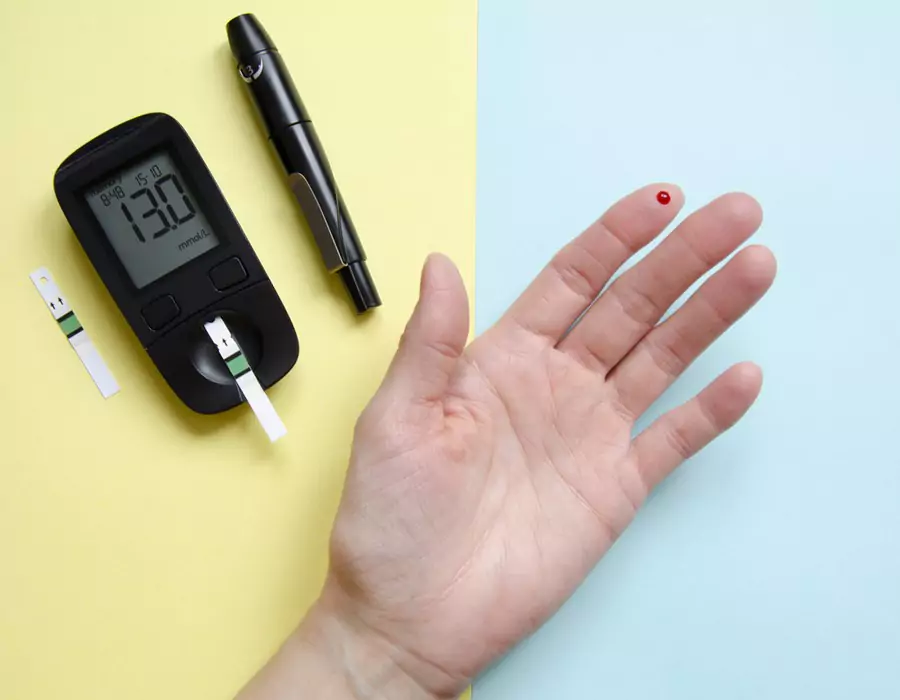






Latent Autoimmune Diabetes in Adults (LADA): A Comprehensive Guide


Table of Contents
- What is LADA?
- The Science behind LADA
- The Autoimmune Aspect: A Key Player in LADA
- The Immune System's Misguided Attack
- The Slow Progression of LADA: A Defining Characteristic
- The Importance of Understanding the Science Behind LADA
- Symptoms of LADA
- How LADA Differs from Other Types of Diabetes
- LADA vs. Type 2 Diabetes
- LADA vs. Type 1 Diabetes
- Tests and Procedures for LADA Diagnosis
- Identifying Autoantibodies
- Other Diagnostic Tests
- Complications of Latent Autoimmune Diabetes in Adults (LADA)
- Cardiovascular Disease
- Nerve Damage (Neuropathy)
- Kidney Damage (Nephropathy)
- Eye Damage (Retinopathy)
- Foot Damage
- Skin and Mouth Conditions
- Bone and Joint Problems
- Hearing Impairment
- Treatment and Management of LADA
- Lifestyle Changes: The First Line of Defense
- The Role of Medication: A Comprehensive Approach
- The SugarMD Weight Loss Formul
- Conclusion
- About The Author
Diabetes, a health condition that is globally recognized and affects millions of individuals, is not a singular, uniform disease. Instead, it presents itself in various forms, each with its distinct characteristics, symptoms and management strategies. Among these forms is a lesser-known but equally significant type known as Latent Autoimmune Diabetes in Adults (LADA) which is sometimes referred to as "type 1.5 diabetes."
To fully comprehend the nature of LADA, it's essential first to understand the broader context of diabetes as a whole. Diabetes is a chronic disease that disrupts the body's ability to regulate blood sugar levels, leading to hyperglycemia, or high blood sugar.
This disruption can have severe long-term consequences, affecting various organs and systems within the body if left unmanaged. Diabetes is primarily divided into two categories: type 1 and type 2 diabetes.
Each type represents a different aspect of how the body fails to regulate blood sugar levels and each requires a unique approach to management and treatment. Type 1 diabetes, often diagnosed in childhood but can occur at any age, is an autoimmune condition.
In this form of diabetes the body's immune system which usually protects against harmful substances like bacteria and viruses, mistakenly attacks and destroys the insulin-producing beta cells in the pancreas? Without insulin, glucose builds up in the bloodstream, leading to high blood sugar levels. People with type 1 diabetes require lifelong insulin therapy to manage their blood sugar levels.
On the other hand, type 2 diabetes the most common form of diabetes, is a metabolic disorder. It's characterized by insulin resistance, a condition where the body's cells become resistant to the effects of insulin. Initially the pancreas compensates by producing more insulin. However, over time, it can't keep up with the demand, leading to a relative insulin deficiency.
What is LADA?
Now, where does LADA fit into this picture? Latent Autoimmune Diabetes in Adults (LADA) is a unique form of diabetes that exhibits characteristics of both type 1 and type 2 diabetes. Like type 1 diabetes, LADA is an autoimmune condition, meaning the body's immune system attacks the insulin-producing cells in the pancreas. However, unlike type 1 diabetes which often begins abruptly in childhood, LADA develops slowly, usually over a period of years, much like type 2 diabetes.
This slow progression can make LADA tricky to diagnose. Many people with LADA may initially be misdiagnosed with type 2 diabetes due to their age and the slow onset of symptoms. However, as the disease progresses and the autoimmune nature of the condition becomes more apparent the need for insulin therapy becomes evident, much like in type 1 diabetes. In conclusion, understanding the different types of diabetes, including LADA, is crucial for appropriate management and treatment. Each type of diabetes has its unique characteristics and challenges and recognizing these differences can lead to more effective and personalized treatment strategies.
The Science behind LADA
To fully grasp the concept of Latent Autoimmune Diabetes in Adults (LADA), it's essential to delve into the scientific aspects that underpin this unique form of diabetes. This involves understanding the role of autoimmunity in its development and the distinctive slow progression that sets it apart from other types of diabetes.
The Autoimmune Aspect: A Key Player in LADA
The term "autoimmune" refers to the body's immune system which is designed to protect against harmful invaders like bacteria and viruses. However, in certain circumstances, this system can mistakenly identify the body's own cells as foreign and launch an attack against them. This is precisely what happens in LADA.
The Immune System's Misguided Attack
In the case of LADA the immune system erroneously targets the beta cells in the pancreas. These cells are crucial as they are responsible for producing insulin the hormone that regulates blood sugar levels. When these cells are destroyed the body's ability to produce insulin is compromised, leading to elevated blood sugar levels, a hallmark of diabetes. This autoimmune response mirrors what happens in type 1 diabetes, another form of diabetes where the immune system attacks and destroys insulin-producing cells. However the similarity between LADA and type 1 diabetes ends here, as the progression of these two conditions differs significantly.
The Slow Progression of LADA: A Defining Characteristic
One of the defining characteristics of LADA is its slow progression. Unlike type 1 diabetes which often manifests rapidly, especially in children and young adults, LADA develops gradually over time. This slow onset often leads to initial misdiagnosis, as it can mimic the characteristics of type 2 diabetes. In the early stages of LADA, individuals may not require insulin therapy, much like those with type 2 diabetes. This can lead healthcare professionals to initially diagnose the condition as type 2 diabetes.
However, as the autoimmune attack continues and more beta cells are destroyed the body's insulin production decreases. Over time the need for insulin therapy becomes apparent, leading to a revised diagnosis of LADA. This slow progression and the subsequent need for insulin therapy are what make LADA unique. It's a form of diabetes that straddles the line between type 1 and type 2 diabetes, exhibiting characteristics of both but fitting neatly into neither category.
The Importance of Understanding the Science Behind LADA
Understanding the science behind LADA is crucial for several reasons. It can help individuals with the condition better understand what's happening in their bodies, leading to more informed decisions about treatment and management.
It can also aid healthcare professionals in making a correct diagnosis, ensuring that individuals with LADA receive the appropriate treatment from the outset. Moreover, a deeper understanding of the autoimmune aspect and slow progression of LADA can pave the way for more targeted research. This could potentially lead to the development of new treatments and management strategies, improving the quality of life for those living with this unique form of diabetes.
Symptoms of LADA
Recognizing the symptoms of Latent Autoimmune Diabetes in Adults (LADA) can be challenging due to its slow progression. However, understanding these symptoms is crucial for early diagnosis and effective management of the condition. The symptoms of LADA are similar to those of other forms of diabetes. They include:
- Excessive Thirst: This is often one of the first signs of LADA. The body tries to get rid of excess glucose through urination, leading to dehydration and a consequent increase in thirst.
- Frequent Urination: As the body tries to eliminate excess glucose the frequency of urination increases.
- Unexplained Weight Loss: Despite eating regularly, individuals with LADA may experience unexplained weight loss. This happens because the body starts using fat and muscle for energy when it can't use glucose effectively.
- Fatigue: People with LADA often feel tired or fatigued. This is because the body isn't able to convert glucose into energy effectively.
- Blurred Vision: High blood sugar levels can cause fluid levels in the body to shift, including in the eyes, leading to blurred vision.
- Slow Healing of Wounds: High blood sugar levels can affect the body's healing process, leading to slow healing of cuts and wounds.
These symptoms often develop gradually over time, making it difficult to recognize LADA in its early stages.
How LADA Differs from Other Types of Diabetes
LADA, often referred to as type 1.5 diabetes, has characteristics of both type 1 and type 2 diabetes. However there are key differences that set it apart.
LADA vs. Type 2 Diabetes
Unlike type 2 diabetes, lifestyle factors such as diet and exercise don't significantly influence the development of LADA. While type 2 diabetes is often associated with obesity and a sedentary lifestyle, LADA can develop in individuals who are of normal weight and physically active.
LADA vs. Type 1 Diabetes
Unlike type 1 diabetes which often begins in childhood, LADA typically develops in adulthood. Furthermore, while the onset of type 1 diabetes is usually rapid, LADA progresses slowly. This slow progression often leads to misdiagnosis as type 2 diabetes.
Tests and Procedures for LADA Diagnosis
Diagnosing LADA involves a series of tests and procedures, primarily aimed at detecting autoantibodies in the blood. These autoantibodies are markers of an autoimmune response which is a characteristic feature of LADA.
Identifying Autoantibodies
The presence of certain autoantibodies in the blood can indicate LADA. These include glutamic acid decarboxylase antibodies (GADA) and islet cell autoantibodies (ICA). GADA is the most common autoantibody found in LADA patients. It targets an enzyme involved in insulin production, leading to a decrease in insulin levels over time. On the other hand, ICA targets the cells in the pancreas that produce insulin.
Other Diagnostic Tests
In addition to autoantibody testing, healthcare providers may also use other diagnostic tests to confirm a LADA diagnosis. These can include:
- C-peptide test: This test measures the level of C-peptide, a byproduct of insulin production, in the blood. Low levels of C-peptide can indicate decreased insulin production which is characteristic of LADA.
- Glucose tolerance test: This test measures how well the body processes sugar. It involves checking blood sugar levels before and after consuming a high-sugar drink.
- Haemoglobin A1C test: This test provides a snapshot of your average blood sugar levels over the past 2 to 3 months. An elevated A1C level can indicate poor blood sugar control, a sign of diabetes.
By combining the results of these tests with the patient's medical history and symptoms, healthcare providers can accurately diagnose LADA and differentiate it from other forms of diabetes.
Complications of Latent Autoimmune Diabetes in Adults (LADA)
Just like other forms of diabetes, Latent Autoimmune Diabetes in Adults (LADA) can lead to a variety of complications that can affect different parts of the body. These complications can significantly impact the quality of life if not managed properly. Let's delve into these complications in more detail.
Cardiovascular Disease
One of the most serious complications of LADA is cardiovascular disease. Diabetes increases the risk of various cardiovascular problems, including coronary artery disease, heart attack, stroke and narrowing of the arteries (atherosclerosis).
Coronary artery disease is a condition where the arteries supplying blood to the heart become hardened and narrowed due to a buildup of cholesterol and other substances, known as plaque. This can lead to chest pain, shortness of breath and other symptoms. In severe cases the plaque can completely block the blood flow to the heart, leading to a heart attack. Similarly, if the blood vessels supplying the brain are affected, it can result in a stroke.
Nerve Damage (Neuropathy)
High blood sugar levels can cause damage to the nerves throughout the body, a condition known as neuropathy. The most common type is peripheral neuropathy which primarily affects the nerves in the legs and feet. Symptoms of neuropathy can range from tingling or numbness in the extremities to more severe complications like burning pain, muscle weakness and loss of reflexes. The pain is often worse at night and can significantly impact the quality of life.
Kidney Damage (Nephropathy)
The kidneys are responsible for filtering waste products from the blood. They do this through a network of tiny blood vessels. However, high blood sugar levels can damage this delicate system, leading to kidney disease or nephropathy.
In the early stages, kidney disease may not have any noticeable symptoms. However, as it progresses, it can lead to kidney failure, requiring dialysis or a kidney transplant. Regular screening for kidney function is crucial for people with LADA to catch and treat kidney disease early.
Eye Damage (Retinopathy)
Diabetes can also affect the eyes, leading to a condition known as diabetic retinopathy. This occurs when high blood sugar levels damage the blood vessels in the retina the light-sensitive layer at the back of the eye. In the early stages, diabetic retinopathy may cause no symptoms or only mild vision problems. However, if left untreated, it can cause blindness. Regular eye exams can help detect diabetic retinopathy in its early stages before it leads to vision loss.
Foot Damage
People with LADA are at risk of serious foot complications. High blood sugar levels can damage the nerves in the feet (peripheral neuropathy), leading to a loss of sensation. This means that cuts and sores can go unnoticed and can develop into serious infections. Poor blood flow to the feet, another complication of diabetes, can slow the healing of these wounds. In severe cases these infections can become so bad that they require toe, foot, or even leg amputation.
Skin and Mouth Conditions
Diabetes can affect the skin in various ways. It can cause dry, itchy skin and make the skin more susceptible to bacterial and fungal infections. Similarly, diabetes can lead to problems in the mouth, including gum infections and dry mouth which can lead to tooth decay.
Bone and Joint Problems
Diabetes can also affect the bones and joints, leading to a higher risk of bone and joint disorders. These can include osteoporosis, a condition that weakens the bones and makes them more prone to fractures and arthritis which can cause joint pain and stiffness.
Hearing Impairment
Hearing impairment is more common in people with diabetes, including LADA. Although the reason for this is not entirely clear, it's thought that high blood sugar levels might damage the nerves and blood vessels in the inner ear, leading to hearing loss.
Treatment and Management of LADA
Latent Autoimmune Diabetes in Adults (LADA), often referred to as "type 1.5 diabetes," is a unique form of diabetes that shares characteristics with both type 1 and type 2 diabetes. Managing LADA involves a combination of lifestyle changes and medication which can help control blood sugar levels and prevent complications.
Lifestyle Changes: The First Line of Defense
While lifestyle factors don't cause LADA, maintaining a healthy lifestyle can help manage the disease. This includes a balanced diet, regular exercise and maintaining a healthy weight.
Balanced Diet
A balanced diet is crucial for managing blood sugar levels. This involves consuming a variety of foods in the right proportions, including fruits, vegetables, lean proteins, whole grains and healthy fats. It's also important to limit the intake of processed foods, sugary drinks and high-fat foods.
Regular Exercise
Regular physical activity can help lower blood sugar levels and boost the body's sensitivity to insulin. This can be achieved through a combination of aerobic exercises, such as walking, swimming, or cycling and resistance training exercises, such as weight lifting.
Maintaining a Healthy Weight
Maintaining a healthy weight can help manage blood sugar levels and reduce the risk of other health complications. Weight loss, if necessary, should be achieved through a combination of a balanced diet and regular physical activity.
The Role of Medication: A Comprehensive Approach
As LADA progresses, insulin therapy becomes necessary. However, some people with LADA may initially manage their blood sugar levels with oral medications.
Oral Medications
Oral medications, such as metformin, are often the first line of treatment for people with LADA. Metformin works by reducing the amount of glucose the liver produces and improving the body's response to insulin. However, as the disease progresses and the body's ability to produce insulin decreases these medications may become less effective.
Insulin Therapy
Insulin therapy becomes necessary as the body's ability to produce insulin decreases. This involves injecting insulin into the body to regulate blood sugar levels. The type of insulin the dosage and the timing of the injections will depend on individual needs and the progression of the disease.
Monitoring Blood Sugar Levels
Regular monitoring of blood sugar levels is crucial for managing LADA. This can help determine the effectiveness of the treatment plan and make necessary adjustments. Monitoring can be done through regular blood tests or continuous glucose monitoring systems.
The SugarMD Weight Loss Formul

In addition to lifestyle changes and medication, supplements can also play a role in managing diabetes and overall health. The SugarMD Weight Loss Formula is a specially designed supplement that targets stubborn body fat and accelerates metabolism. It can help manage weight, a crucial aspect of diabetes care. With its unique blend of natural ingredients the SugarMD Weight Loss Formula can help you reach your weight loss goals and enhance your overall wellbeing.
Conclusion
Latent Autoimmune Diabetes in Adults (LADA) is a unique form of diabetes that shares characteristics with both type 1 and type 2 diabetes. Understanding this condition, recognizing its symptoms and managing it effectively can help those affected lead a healthier life.
About The Author
Meet Dr. Ahmet Ergin a highly skilled and dedicated endocrinologist with a passion for diabetes care. Dr. Ergin earned his medical degree with honors from Marmara University in Istanbul. He completed internal medicine residency and endocrinology fellowship at Cleveland Clinic.
Dr. Ergin is board-certified in Internal Medicine, Endocrinology, Diabetes and Metabolism due to his vast medical expertise. He's a certified diabetes educator, author of "The Ultimate Diabetes Book," and founder of "the SugarMD YouTube channel."
Dr. Ergin offers exceptional diabetes care to his patients in Port Saint Lucie, FL, helping them manage effectively. Disclaimer: These statements have not been evaluated by the Food and Drug Administration. Information on this website isn’t intended to treat, cure or prevent any disease. Discuss with your doctor and do not self-treat.
Written By Dr. Ahmet Ergin
457 total articles
Meet Dr. Ahmet Ergin, a highly skilled and dedicated endocrinologist with a passion for diabetes care. Dr. Ergin earned his medical degree with honors from Marmara University in Istanbul. He completed internal medicine residency and endocrinology fellowship at Cleveland Clinic. Dr. Ergin is board-certified in Internal Medicine, Endocrinology, Diabetes, and Metabolism due to his vast medical expertise. He's a certified diabetes educator, author of “The Ultimate Diabetes Book,” and founder of “the SugarMD YouTube channel.” Dr. Ergin offers exceptional diabetes care to his patients in Port Saint Lucie, FL, helping them manage effectively. For a closer look into his insights and experiences, connect with Dr. Ahmet Ergin on LinkedIn, Instagram, and YouTube.”
Disclaimer: These statements have not been evaluated by the Food and Drug Administration. Information on this website isn't intended to treat, cure or prevent any disease. Discuss with your doctor and do not self-treat.
Products















